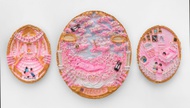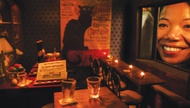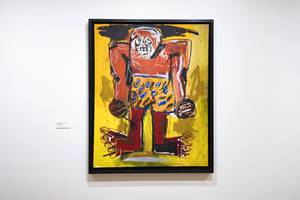
Block 17 Through December 7; Monday-Friday, 9 a.m.-5 p.m.; Saturday, noon-5 p.m.; free. Donna Beam Fine Art Gallery, 702-895-3893.
"Clark’s Las Vegas Townsite Map” (1905) greets visitors to the Block 17 exhibition at UNLV’s Donna Beam Gallery. The vintage map grids Downtown Las Vegas into numbered chunks. “Block 17”—between Ogden and Stewart Avenues—designated the neighborhood where early-1900s African Americans settled. Today, Block 17 nods at the origins of our black community while seemingly breaking every boundary the block was meant to contain.
Vibrant and thoughtful, Block 17 showcases 18 African American artists living in Las Vegas and working in printmaking, drawing, ceramics, sculpture, mixed-media, video and installation. A third are under the age of 30; another third are connected to UNLV; some exhibit often, others rarely. Although group shows tend to wallow in eclecticism, Block 17—curated by Donna Beam director Jerry Schefcik—literally hangs together, the variety in medium, material and style balanced through coherent presentation.
Among the standouts is Brent Holmes’ installation “Clotilda,” named after the last known U.S. slave ship. The piece consists of a box topped with a clay-boat fountain, a black jar of charcoal, a white jar of cotton wipes, a stack of newsprint, a towel and headphones. The soundtrack layers pleasant instructions over a soothing melody by 18th-century black composer Joseph Bologne. Visitors are told to smear charcoal on their faces and “Talk about … occasions in which you have been pulled over by law enforcement. Speak of the heart palpitations that occurred during those incidents. Question whether the heart palpitations you experienced are based on a legacy of genetic abuse.” The toy-boat fountain—combined with a DIY identity simulation—is as disarming as it is pointed. By inverting the demeaning history of blackface, Holmes produces a rich commentary on racial oppression and injustice.
Sloane Siobhan and Miguel Rodriguez also take on race with incisive, emotional works—the former in a sculptural mixed-media piece featuring suffocated heads ironically sprouting from lush greenery, the latter with a spectrum of ceramic anti-Santa Clauses who are anything but cherubic white. Eyob Mergia contributes two vigorous, large-format mixed-media collages referencing rising ethnic and religious tensions in his native Ethiopia, the complex layering in the works producing an impressive formal and narrative depth.
Other artists in Block 17 engage social justice indirectly, if at all. Chase McCurdy’s paintings of “Neo” portray an animistic, geometric figure who seemingly gazes back at the viewer like a trickster from sci-fi myth. Ashanti McGee’s mute video, “A Year on Dashcam,” intimately but self-consciously documents the cumulative moments constituting the artist’s life, arousing curiosity and empathy. Ashley Hairston Doughty’s prints and sculpture shift language from the communicative to the aesthetic realm, delivering social commentary and humorous, artistic insight along the way.
Expert draftsmanship also populates Block 17 with subtle, moving portraiture by Lance Smith; stylized desert landscapes by Vicki Richardson; and delightful pen-and-marker illustrations of payday Las Vegans by Mariah GW. Block 17 is a significant, resonant show that everyone should see.






